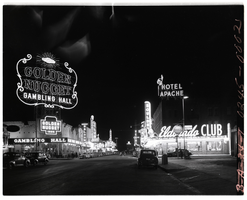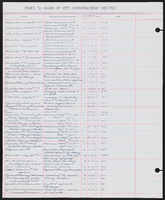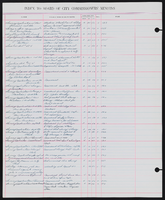Search the Special Collections and Archives Portal
Search Results
Grant Sawyer oral history interview
Identifier
Abstract
Oral history interview with Grant Sawyer conducted by Perry Kaufman on May 12, 1972 for the Ralph Roske Oral History Project on Early Las Vegas. In this interview, Sawyer discusses his campaign for Governor of Nevada and the differences between northern Nevada and southern Nevada social life. He then describes winning the election for Governor, the gaming industry, and explains why gaming was significant to his political career. Lastly, Sawyer discusses the Nevada Gaming Commission before and after he was Governor, and actions that he took against organized crime.
Archival Collection
UNLV Libraries Collection of Primadonna Resorts, Inc. Promotional Materials and Reports
Identifier
Abstract
The UNLV Libraries Collection of Primadonna Resorts, Inc. Promotional Materials and Reports includes annual reports, financial reports, a press kit, press releases, promotional materials, and newspaper and magazine clippings for Primadonna Resorts, Inc. in Primm and Las Vegas, Nevada dating from 1970 to 1998.
Archival Collection
Elizabeth Garrison oral history interview
Identifier
Abstract
Oral history interview with Elizabeth Garrison conducted by Walter John Ritzau on February 25, 1977 for the Ralph Roske Oral History Project on Early Las Vegas. Garrison first talks about her schooling in Las Vegas, Nevada, the atomic testing, the Devils Hole in Ash Meadows, early church involvement, and some of the environmental aspects of Las Vegas. Garrison later describes her work for the Central Telephone Company and the Helldorado Parade.
Archival Collection
Carey Burke oral history interview
Identifier
Abstract
Oral history interview with Carey Burke conducted by Terri Goodsell on March 12, 1981 for the Ralph Roske Oral History Project on Early Las Vegas. Burke talks about his schooling at St. Joseph’s Catholic School and Rancho High School. Burke also talks about the recreational activities he took part in during schooling, such as going to Lake Mead and joining a YMCA (Young Men’s Christian Association) camp. Burke then describes the Helldorado customs and his hobby of collecting gaming memorabilia.
Archival Collection
Audio clip from interview with Milton I. Schwartz by Claytee White, May 4, 2004
Date
Archival Collection
Description
Part of an interview with Milton I. Schwartz on May 4, 2004. In this clip, Schwartz discusses his life after the military and working in Las Vegas.
Sound

Film transparency of Fremont Street at night, Las Vegas, Nevada, July, 1949
Date
Archival Collection
Description
Image

Film transparency of Fremont Street at night, Las Vegas, Nevada, July, 1949
Date
Archival Collection
Description
Image



